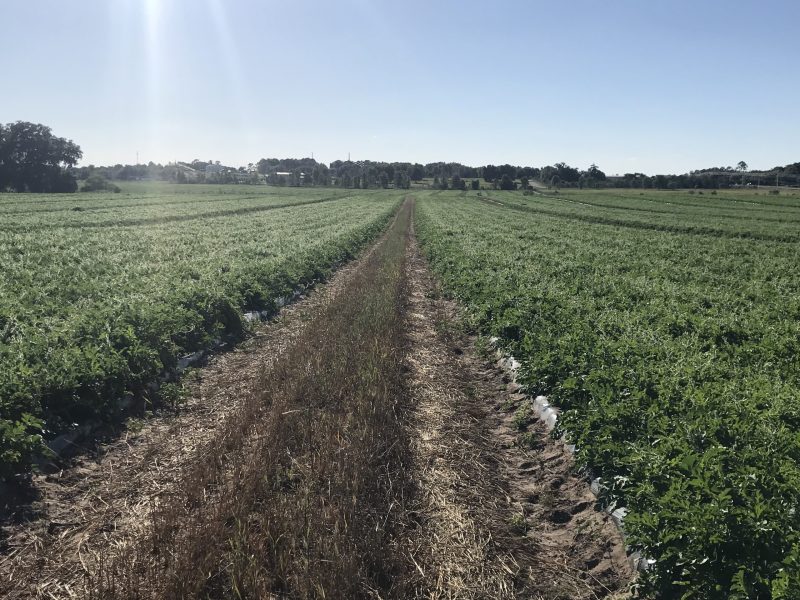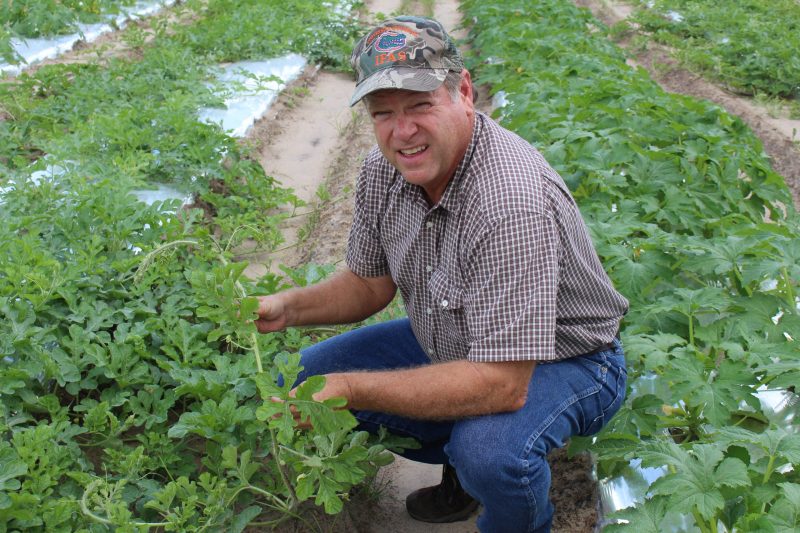These Research and Extension demonstrations were conducted during the spring of 2020 and 2021 comparing controlled-release fertilizers (CRF) to conventional fertilizer programs. These were made possible by the funding assistance of the Florida Watermelon Association, Florida Department of Agriculture and Consumer Services, Harrell’s Fertilizer, other industry partners, and cooperating farmers. In 2020, this demonstration took place at a local farm near Live Oak, Florida. In 2021, similar demonstrations took place on three different farms within the Suwannee Valley area. On May 3rd, 2021, one of the cooperating farms hosted the “2021 Watermelon Field Day” in Levy County, Florida. This event allowed attendees to participate in discussions on nutrient management and other best management practices as well as observe the participating farm’s CRF versus conventional fertilizer programs.
Objective
The objective of this 2-year project was to evaluate a controlled-release nitrogen source as an alternative to in-bed applications of conventional, soluble, sources of nitrogen fertilizers. Prior research at the North Florida Research and Education Center (NFREC)-Suwannee Valley with CRF, especially nitrogen, had shown great promise in watermelon, carrot, and corn production. Our objective in these demonstrations was to expand the research onto commercial watermelon farms in the Suwannee Valley. These large-scale on-farm demonstrations compared a season-long CRF to the conventional fertilizer programs typically being used on these farms. This included soluble bed fertilizer followed by liquid fertigation events during the season.

One of the on-farm watermelon fertilization trial comparing traditional with control-released fertilizer. Credit: Bob Hochmuth, UF/IFAS
–
Treatments
The demonstrations in 2020 and 2021 took place on various farms in the Suwannee Valley. In 2020, the on-farm demonstration was conducted where the grower split a 20-acre field in half to compare 10 acres of a CRF fertilizer program of 15-3-21 (N- P2O5– K2O) targeting 150lbs/acre of N, to 10 acres of their conventional fertilizer program of 8-8-32 (N- P2O5– K2O) at 560lbs/acre in the bed followed by fertigation events during the season. These fertigation events were initiated based on petiole-sap testing data. In 2021, the demonstrations were conducted on 3 different farms where each farm grew watermelons on 3 different sections, 2 different CRF fertilizer sections, and 1 section of conventional fertilizer. Each grower had a CRF-1 section with an analysis of 15-3-21 (N- P2O5– K2O) and targeted a rate of 150 lbs/acre of N. This fertilizer was comprised of a fully polymer-coated blend. The CRF-2 section had an analysis of 17-3-22 (N- P2O5– K2O) and also targeted 150 lbs/acre of N. The CRF-2 blend consisted of nearly all N and K2O being polymer-coated, but other nutrients were left uncoated. The third treatment in each field was a conventional fertilizer program that would be considered the “growers standard” which consisted of a soluble granular fertilizer in the bed, followed by liquid fertilizer fertigation.

Bob Hochmuth, UF/IFAS Regional Specialized Extension Agent, evaluating nutrient status in a Suwannee Valley watermelon grower’s field.
–
Results
2020 Results
In the 2020 demonstration, each treatment resulted in similar yields of approximately 65,000 lbs/acre. The seasonal soil moisture data shows there was no leaching rain event until the first week in June, well into the harvest season, and there was no over-irrigation event during the season, resulting in very little to no nitrate-N leaching below the watermelon root zone throughout the season. One important aspect of the irrigation program was that it was totally automated using short irrigation events (maximum 1 hour events) as needed. The results of this study indicate that both conventional and CRF programs can be used to produce adequate yields in a well-managed irrigation and production system.
2021 Results
Throughout the growing season, Farm 1 was able to maintain nitrogen levels within or above the target range. Data collected at this farm resulted in very similar yields of approximately 70,000 lbs/acre for both CRF and conventional fertilizer treatments. Farm 2 suffered severe Fusarium wilt damage, which ultimately resulted in any yield data being unusable for comparison purposes. Despite the implementation of high irrigation events and early season transplant establishment issues, the demonstration at Farm 3 resulted in comparable but slightly different yields. The CRF treatments combined yielded 72,820 lbs/acre, with the early harvest yielding higher than the conventional section. In addition, the conventional fertilizer treatment resulted in slightly higher total yields of 78,375 lbs/acre and resulted in a better overall watermelon size. The excessive irrigation events, especially early in the season, likely leached CRF nutrients as soon as they were released from the polymer coating resulting in the need for fertigation events to be implemented during the fruit enlargement stage of growth.
In both 2020 and 2021, both CRF and conventional fertilizer programs performed similarly for yield when irrigation was properly managed. At one farm, we also confirmed nutrients, such as nitrogen, once released from the polymer coating, are just as vulnerable to leaching as conventional, soluble forms of nitrogen.
- 2024 Watermelon Season Wrap Up - June 21, 2024
- Weekly Watermelon Update – June 3 - June 7, 2024
- Weekly Watermelon Update #10 – May 20 - May 24, 2024
